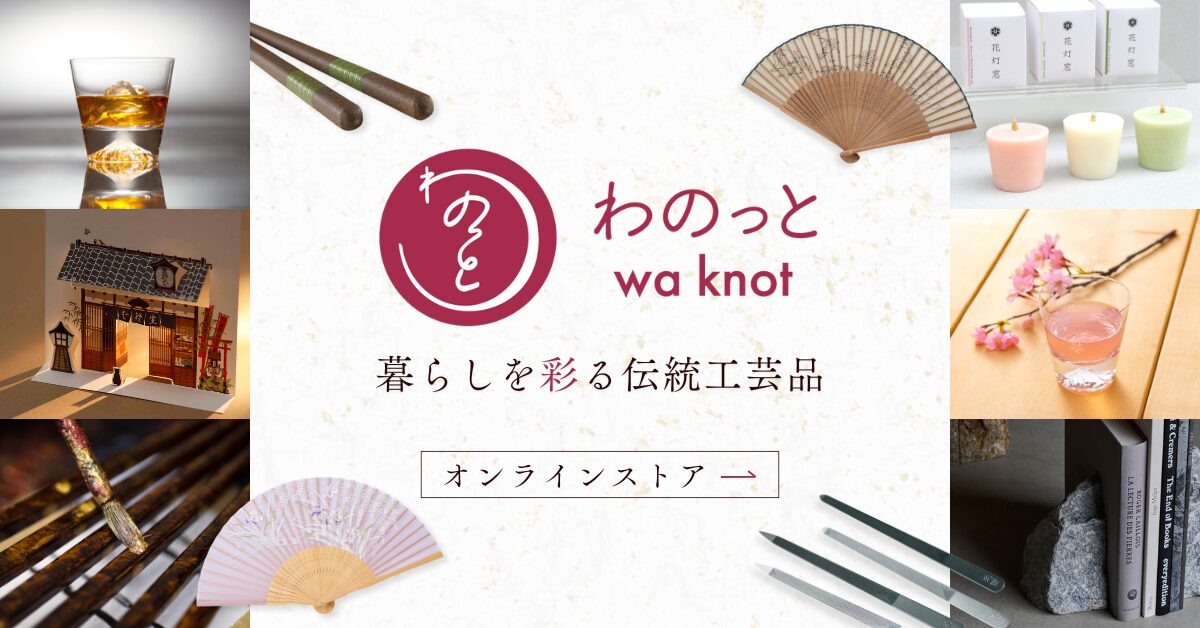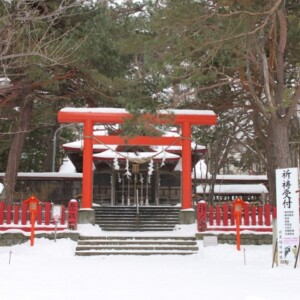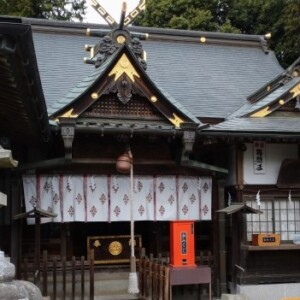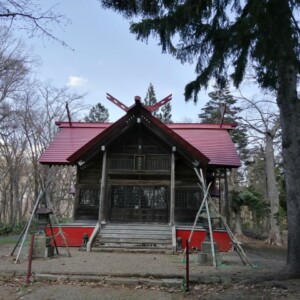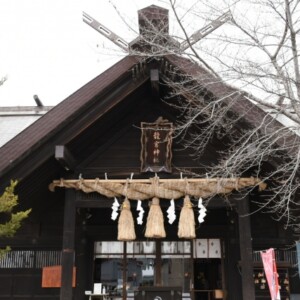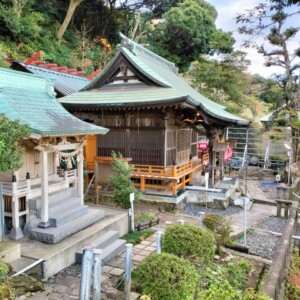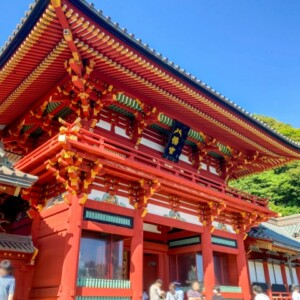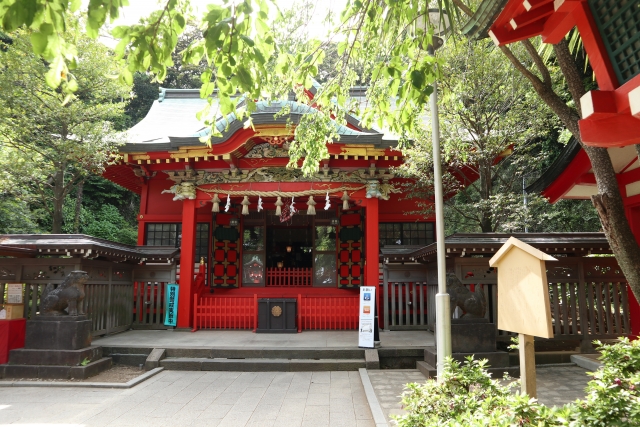
Eshima Shrine Nakatsugu|A complete guide to the history and highlights of this ancient temple dedicated to Ichisunjimahiru-no-Mikoto, one of the three shrines on Enoshima.
Eshima Shrine, the representative sacred site of Enoshima, consists of three shrines: Henzumiya, Nakatsukumiya, and Okutsukumiya. Known for its beautiful vermilion Gongen-zukuri style shrine pavilions and gorgeous flower-and-bird paintings decorating the ceiling of the hall of worship, Nakatsu-gu Shrine is an important center for the three Eshima Shrine shrines, attracting the faith of those who wish for good luck in marriage and the advancement of the performing arts.
Outline and basic information about Nakatsugu Shrine of Eshima Shrine
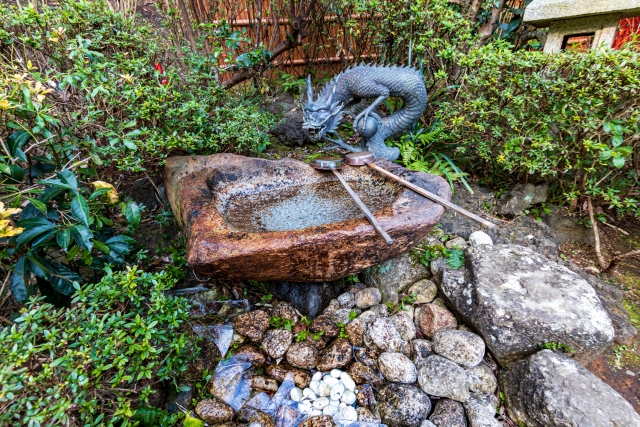
Eshima Shrine Nakatsukumiya is one of the three shrines that make up Eshima Shrine, located in Enoshima, Fujisawa City, Kanagawa Prefecture. Located in the center of Enoshima, the shrine has long been beloved by many worshippers as a shrine dedicated to Ichisunjimahiru-no-Mikoto.
The entire Eshima Shrine is one of the three great Benzaiten shrines in Japan and is known as a venerable shrine dedicated to the three Munakata goddesses. Nakatsugu Shrine is one of the most beautiful of them all, boasting beautiful shrine architecture and a rich history, and is an important spot for sightseeing in Enoshima.
History and Origin
Nakatsu-gū, originally Kaminomiya, was founded by Jikaku Daishi in 853, the third year of Emperor Montoku’s reign. It is an ancient shrine with a long history of more than 1,100 years since its foundation in the early Heian period.
According to the “Eshima Engi,” the origin of Eshima Shrine as a whole dates back to the 13th year of Emperor Kinmei (552), when a deity was enshrined in a cave on the island (goguro, now an iwaya) at the order of Emperor Kinmei. Later, in 814 (Konin 5), Kukai built Iwaya Hongu, and in 853 (Ninju 3), Jikaku Daishi built Kaminomiya (Nakatsukiya), thus laying the foundation for the present sanguine shrine system.
In the Edo period (1603-1868), Tsunayoshi Tokugawa, the fifth shogun, rebuilt the shrine in the Gongen-zukuri style, consisting of a main hall, a hall of offerings, and a hall of worship, and completed the magnificent shrine pavilions. In recent years, the shrine was completely renovated in 1996, reproducing the vermilion color of the original shrine pavilions of the second year of the Genroku era. In 2011, the floorboards of the hall of offerings and the hall of worship were replaced, the shrine’s talisman office was rebuilt, and a garden with a suikinkutsu (water fountain) was opened beside the shrine pavilions.
Gods and Benefits
Nakatsu-miya Shrine is dedicated to the deity Ichisunshima-hime no Mikoto. Ichikishimahime-no-Mikoto is one of the “Munakata-san-no-Mikoto” (Three Goddesses of Munakata), who were born from the oath between Amaterasu and Susano-ono-Mikoto.
Ichisunjimahiru-no-Mikoto has long been associated with Benzaiten, and has been worshipped as a god of music, entertainment, wisdom, and treasure. She is especially believed to bring good luck in marriage, the advancement of the performing arts, academic achievement, and business prosperity, and is visited by many worshippers. In the Edo period (1603-1867), many common people began to visit the shrine as a god of entertainment, music, wisdom, fortune, and treasure.
Highlights and Features of Eshima Shrine Nakatsu-miya
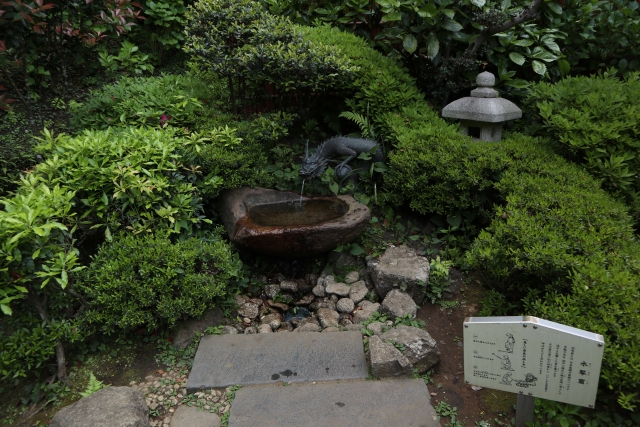
The main attraction of Eshima Shrine Nakatsukumiya is its beautiful architecture and rich decorations. The vermilion-colored Gongen-zukuri shrine pavilions are one of Enoshima’s representative structures, and the ornate decorations inside the hall of worship continue to fascinate visitors.
The vermilion-colored Gongen-zukuri shrine pavilions
The shrine pavilions of Nakatsukumiya Shrine were built in the Gongen-zukuri style, consisting of a main hall, a Shinto hall, and a worship hall, and are characterized by their beautiful vermilion color. The current shrine was completely renovated in 1996 to reproduce the vermilion color of the original shrine pavilions from the second year of the Genroku era (1688-1704), and to convey the splendid architectural style of the Edo period.
The Gongen-zukuri style, in which the main hall and the worship hall are connected by a mint hall, is a highly prestigious architectural technique that can be seen at Nikko Toshogu Shrine and other shrines. Located in the center of Enoshima Island, the Nakatsukumiya shrine pavilions are in harmony with the surrounding natural environment, yet still have a strong presence with their vivid vermilion color.
Flower and bird paintings and sculptures on the ceiling of the hall of worship
The ceiling of the hall of worship is decorated with 154 seasonal flower-and-bird paintings and carvings, and the shrine has been reconstructed with a classical elegance and extreme colorfulness. These flower-and-bird paintings are one of the major highlights of Nakatsukangu Shrine, and are magnificent works of art that express the beauty of nature throughout the four seasons.
The vast number of 154 paintings of flowers and birds, each painted with great care, richly expresses the seasons of spring, summer, fall, and winter. When visiting the temple, we encourage you to look up at the ceiling and take the time to appreciate these beautiful decorations. These decorations are the culmination of the craftsmanship of the Edo period, and are a testament to the high artistic standards of the time.
Garden with a suikinkutsu (water fountain)
A garden with a suikinkutsu has been opened beside the shrine pavilion (open 9:00 a.m. to 4:00 p.m. / free of charge). Suikinkutsu is one of the acoustic devices in the Japanese garden, which produces beautiful sounds when water drops fall into a jar buried in the ground.
This garden was newly developed in 2011 and has become a popular place for visitors to relax and spend time in peace and quiet. The cool sound of the suikinkutsu, combined with the natural environment of Enoshima, provides visitors with a healing experience. The garden is open to the public free of charge, and visitors are welcome to drop by during their visit to the temple.
Guide to Worship
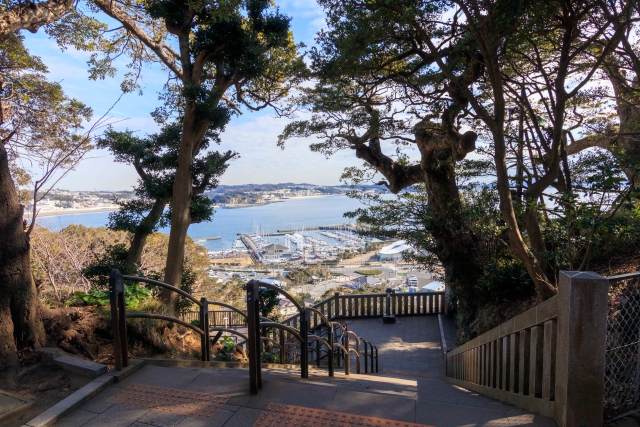
It is common practice to visit Nakatsu-miya Shrine as part of the overall three shrine visits to Eshima Shrine. It is believed that by visiting Hetsumiya Shrine, Nakatsumiya Shrine, and Okutsumiya Shrine in that order, one can receive the full range of the divine virtues of Ejima Shrine.
Worship Etiquette and Manners
The etiquette and manners for worshipping at Nakatsu-miya Shrine are the same as those used at most Shinto shrines. Before passing through the torii gate, bow, and purify your hands and mouth at the hand- and mouth-cleansing booth before proceeding to the shrine pavilions. In front of the hall of worship, pray with all your heart in the manner of “Ni-hai Ni-hatte Ichi-hai” (two beats for one worship).
When worshipping, you can also appreciate the beautiful decorations on the ceiling of the hall of worship, which is decorated with 154 seasonal flower-and-bird paintings and sculptures. However, it is important to be quiet while visiting the shrine and to avoid disturbing other worshippers.
When taking photographs, please refrain from taking pictures inside the shrine pavilions, and remember to be considerate of your surroundings when taking pictures of the exterior. In particular, there may be restrictions on photographing valuable cultural assets such as flower-and-bird paintings for the sake of protection.
Points for Visiting the Three Shrines of Eshima Shrine
There are three shrines at Eshima Shrine: Hetsumiya, Nakatsumiya, and Okutsumiya. If you visit on foot, the second shrine you will visit is Nakatsumiya. The official order of visiting the three shrines is Henzumiya, Nakatsumiya, and Okutsumiya, and is completed by visiting the three Munakata Goddesses enshrined at each shrine in turn.
It takes about 5 to 8 minutes from Hentsumiya to Nakatsumiya. For those who have difficulty walking, there is a second escalator stop a short walk from Hengu, from which you can take the escalator to the front of Nakatsugu Shrine without climbing the stone steps.
It is recommended to allow approximately 2 hours for the visit to the three shrines. We recommend that you take your time to visit each shrine and enjoy the sights and sounds of the shrine grounds.
Red Seal and Good Luck Charm Information
Red seals are available at Nakatsugu Shrine, and votive talismans are available at the Shu-no-Torii gate, at three locations on the Henzingu Shrine grounds, at Nakatsugu Shrine, and at Okutsumiya Shrine. At Eshima Shrine, red seals can be selected from 10 different types at the red seal station near the shrine pavilions, so it is possible to receive more than one red seal as a commemorative gift for visiting the three shrines.
There are more than 60 types of amulets at Ejima Shrine, making it difficult to choose one! One of the most popular is the “Ryujin-mamori” (dragon god protection). We also recommend the Biwa-mamori, a cute biwa-shaped amulet with a depiction of Benzaiten (a goddess of fortune). It is said to bring good fortune and improve the performing arts.
Eshima Shrine is also known as a power spot for the fulfillment of love. It is said that if you write your name on the pink “Koi-musubi/en-musubi ema,” it will bring you a good marriage. In particular, Ichisunjimahiru no Mikoto, enshrined in Nakatsugu Shrine, is also believed to be the god of marriage, and is therefore especially recommended for those wishing for a good marriage.
Access/Use Information

The most common route to Eshima Shrine Nakatsugu Shrine is to first cross over to Enoshima and then walk to the shrine via Hengu Shrine. Public transportation is relatively easy to access from central Tokyo, and many people visit the shrine for both sightseeing and worship.
Access
Ejima Shrine can be accessed by three different train lines. It is a 15-minute walk from Katase Enoshima Station on the Odakyu Electric Railway line, a 19-minute walk from Enoshima Station on the Enoshima Electric Railway line, and a 20-minute walk from Shonan Enoshima Station on the Shonan Monorail line to the vermilion torii gate at the entrance to Eshima Shrine.
The most accessible station is Katase Enoshima Station on the Odakyu Line, which is approximately one hour from Shinjuku Station. From the station, cross the Enoshima Benten Bridge and walk from the Shu-no-Torii to the Hengu Shrine and then to the Nakatsukumiya Shrine.
For access by car, it takes about 40 minutes</parameter> from the Chigasaki Kaigan IC of the Shin-Shonan Bypass. However, there is no parking at Eshima Shrine, but there are several parking lots on the island from which you can walk. Public transportation is recommended, especially on weekends and during the tourist season, as the parking lots are crowded.
Hours of Adoration, Fees, and Parking Information
The hours of worship at Eshima Shrine are from 8:30 am to 5:00 pm, and there is no charge to visit. A garden with a suikinkutsu (water fountain) has opened beside the Nakatsugu Shrine (open 9:00 a.m. to 4:00 p.m., free of charge), so please enjoy it in conjunction with your visit to the shrine.
An additional fee is required to use the eskar. The eskers are located from section 1 to 3, and the eskers (section 2)… Hengtsugu~Nakatsugu is the most convenient way to get to Nakatsugu. Please check locally for fares and operation times.
There are several parking lots on Enoshima, but rates and capacity vary with each lot. We recommend arriving early, as the parking lots are often full during the tourist season and on weekends. For barrier-free access, it is possible to avoid the stone steps by using an escalator, but we recommend that you check the details in advance.
<Address> 2-3-8 Enoshima, Fujisawa City, Kanagawa Prefecture, 251-0036, Japan
Reference site
Eshima Shrine Official Web Site: http://enoshimajinja.or.jp/
Fujisawa City Tourism Official Website: https://www.fujisawa-kanko.jp/


